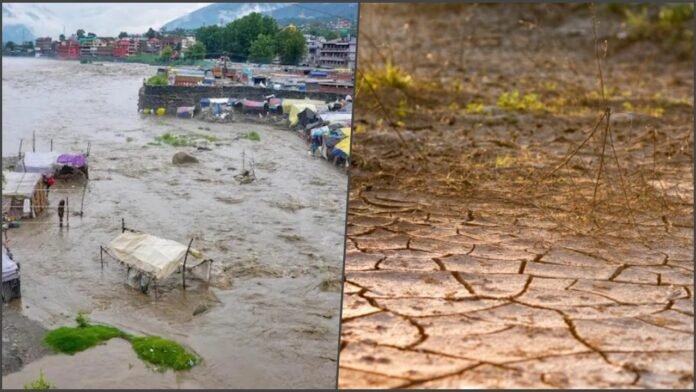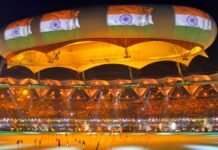
New Delhi: A combination of Western Disturbances and Westerly Monsoon winds brought heavy rains over North India last week, making the region surplus at this time of the year. But 12 states in central, southern, and northeastern states like Telangana, Kerala, Karnataka, and Bihar have seen deficiency in monsoon rains. Jharkhand is still passing through the phase of weak monsoon. According to a Hindustan Times report] IMD’s rainfall data for the monsoon that usually begins on June 1 shows that all southern states, except Tamil Nadu, have received less rain than expected this season.
In the south in the first week of July, heavy rains were confined to the coastal areas of Kerala and Karnataka, the mainland did not receive substantial rainfall; So much so that the sowing of crops has been delayed in parts of Telangana, Andhra, Karnataka, and Kerala. Karnataka and Telangana governments have spoken of a possible monsoon drought. According to the bulletin of the Telangana State Development and Planning Society (TSDPS) on Tuesday, the monsoon season is considered to have started from June 1, till July 11, and the state recorded 150.4 mm of rainfall. While the normal rainfall should be 197.5. That is, this year Telangana has received 24% less rainfall in the monsoon season. During this period last year, the state received heavy rainfall of 395.6 mm. It was almost double the rainfall than normal.
Telangana is 65% rain deficient
“Compared to last year, Telangana has witnessed 65% rainfall deficiency so far this year,” the bulletin said. It added that the monsoon in the state began on June 24 and has been erratic. Barring Vikarabad, Sangareddy, Siddipet, and Narayanpet, which have recorded slightly above-normal rainfall so far, all the remaining 29 districts received deficient rainfall. There has been a deficit of 5% in the Jangaon district and -51% in the Khammam district. In Karnataka, officials said most major dams such as the Krishnarajasagar (KRS) dam, a vital water source for Bengaluru and a supplier of Cauvery water for drinking purposes, are almost drying up. The water level of the dam is 30 feet, which is a maximum of 124.8 feet. Comparatively, last year the water level of the dam was 106.5 feet.
No water in the major dams of Karnataka
Similarly, the Tungabhadra dam, which supplies water to the Hyderabad and Karnataka regions, currently holds only 4.1 TMC of water, much less than last year’s 43.9 TMC. According to the Karnataka State Natural Disaster Monitoring Cell, the catchment areas responsible for replenishing rivers like Kaveri and Tungabhadra in Karnataka have received less than a third of normal rainfall during the first 35 days of the monsoon season. Expressing concern, a senior government official said, “Almost all the areas are cloudy but the average rainfall is not more than 12 cm. This has put huge pressure on the reservoirs and if the situation is not reversed, power generation and supply of potable water may be affected.
Kerala recorded 31% less rainfall
Kerala has recorded 31% less rainfall than normal so far this monsoon season. “Except for some parts of north Kerala, most other areas have received scanty rainfall,” said an official of the Kerala Disaster Management Department. He said nine out of 14 districts are severely rain deficient. With only a 19% deficit, Andhra Pradesh is in a better position than other southern states. The IMD said that the monsoon in South India has been weak since its inception mainly due to the impact of Cyclone Biperjoy. IMD scientist Jenamani said, ‘Due to the combination of western disturbance and monsoon wind, heavy rains occurred in the north. Monsoon has moved east and will bring rain in Uttarakhand and Uttar Pradesh in the coming days. We are hopeful that with the formation of pressure in the Bay of Bengal, rains will resume in South India in a few days.

Monsoon weak in Bihar, Jharkhand, Odisha as well
The eastern states of Bihar (33%), Jharkhand (43%), and Odisha (26%) are also facing rainfall deficiency. However, a sufficient amount of rain has been received in West Bengal. Except for Assam, all the northeastern states are rain deficient, although the average rainfall received in these states is more than the country’s average. The average rainfall of any northeastern state is almost twice the average of mainland Indian states. For example, Arunachal Pradesh has received 484 mm of rain this monsoon season, which is 28% less than normal, while Rajasthan has received just 249 mm of rain, 155% more. Due to heavy rains, water logging and flood situation has arisen in the states of North India. The Beas River has caused havoc in Himachal. The Ghaggar River is creating havoc in Punjab.





















































